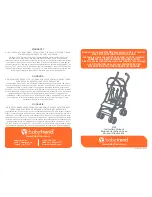
User manual - CONTROLLER PUR-94D
presents the principle of relay outputs operation for two thresholds mode for an
example values of other parameters. In this mode parameter
“SEt2”
is accessible in common
with
“SEtP”
, this parameter describes a second threshold of the relay output. The parameters
“HYSt”
,
“modE”
,
“t on”
,
“toFF”
,
“unit”
and
“AL”
are connected with both
“SEtP”
and
“SEt2”
thresholds. While the controlling process, the relay output changes his state depends
of both
“SEtP”
and
“SEt2”
thresholds in similar way as it was described in one threshold
mode.
If two threshold mode is used,
“modE”
parameter defines state of the relay output when
the input value occurs in a particular zone defined by
border values
of both
thresholds
. The
relay can be turned on if the input value is contained in
zone A
(
“modE”
=
”in”
) or
zone B
(
“modE”
=
”out”
) and turned off if it is contained in the second one
The sequence of thresholds “
SEtP
” and “
SEt2
” can be set in any order, due to the
control of relay outputs is done depend on difference between thresholds values
(
zone A
) and outside of threshold values (
zone B
).
6.3.3.
PWM Controlling
In devices equipped with the OC type output, the user can switch this output to the
special
“PULS”
mode. This mode allows the user to adjust the output pulse width (Pulse
Width Modulation) by means of a source signal defined in the parameter
“Sour”
and the
parameter settings
“InLo”
,
“InHi”
,
“PEri”
,
“H on”
,
“HoFF”
and
“AL”
(for the exact
description of these parameters, see chapter
).
PWM allows the user to change the width (duration) of high and low levels by defining the
range of the input signal (in
"InLo"
and
"INHi"
parameters), the duration of this signal (
"PEri"
parameter) and the source value (
“Sour”
parameter). The input signal, changing within this
range, will linearly vary the percentage share of the high status over the entire period of the
signal in accordance with fill factor
D
. In those cases where the source value is less than the
value of the
"InLo"
parameter, the fill is equal to
0
% (i.e. the output signal will always be in low
level state), and when the source value is greater than the value of the
"INHi"
parameter the
fill will be equal to 100% (i.e. the output signal will always be in high level state).
Factor
D
is defined by the following formula:
D
=
t
T
where:
t – the duration of the high status for a single pulse,
Τ – the duration of the signal.
31
i
















































